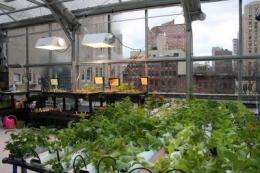Fresh city tomatoes, any time

Why not produce lettuce, beans and tomatoes where most of the consumers are to be found: in the city? The flat roofs of many buildings are well-suited for growing vegetables. Rooftop greenhouses can also make use of a building's waste heat and cleaned waste water.
What could be fresher? On his way home from the office, the computer scientist harvests tomatoes from his company's rooftop greenhouse. The plants growing there thrive on the building's purified waste water and waste heat. Plantation systems such as this are still unheard-of in Germany. But they may make their debut soon: "In our inFarming project – which is short for 'integrated farming' – we are developing solutions that can be speedily implemented for the urban landscape. Our goal is to grow vegetables atop existing buildings," certified engineer Volkmar Keuter, project manager at the Fraunhofer Institute for Environmental, Safety and Energy Technology UMSICHT in Oberhausen, explains. Actually, there are many varieties of plants suitable for growing on city farms. "Along with vegetables and fruit, we also want to look into growing plants that produce active ingredients for medications."
The benefits: reducing the area required for agriculture, almost no transportation costs and, as a result, lower emissions - not to mention the boost in freshness when the tomatoes grow right on the consumer's roof. Waste heat from buildings and additional solar modules would be enough to supply the greenhouses with the energy they need. Semi-transparent solar cells are ideally suited for the purpose because they do not rob the plants of the light they need to grow. Water consumption is minimal, too: in a self-contained system, water used for the plants is circulated back, cleaned and reused. Multifunctional microsieves and photocatalytic and thus self-cleaning coatings keep the water quality high. Nutrients for the plants can even be filtered out of rainwater and waste water. "Our concept relies on hydroponic systems or hydrocultures. A thin, controlled film of water is all it takes for plants to absorb needed nutrients. The advantage: the yield is ten times higher, and soil is too heavy for many building roofs. That is why we are working on systems to supply plants with nutrients," the researcher reports.
In Germany there are around 1,200 million square meters' worth of flat-roofed, non-residential buildings. Roughly a quarter of this area could provide herbs and vegetables with a place to thrive. The plants would then absorb some 28 million metric tons of 28 CO2 in Germany's cities each year. This is the equivalent of 80 percent of CO2emissions produced by industrial operations in Germany. "Our cooperation partner – BrightFarm, a US firm - has already completed several projects in New York. The company started out in 2005 with a small research institution on a raft before going on to build greenhouses atop a school for teaching purposes. This year, 1500 square meters' worth of roof space were developed in both the South Bronx and Brooklyn. Here in Germany, we are building an applications lab at the Fraunhofer-inHaus-Center in Duisburg. This is the Fraunhofer innovation workshop for intelligent room and building systems," certified geographer Simone Krause, Volkmar Keuter's colleague, points out.
The idea for urban agriculture is not new and is a hot topic of discussion at international level. Urban, vertical, sky or rooftop farming are the names by which the various approaches are known. Worldwide, futuristic, garden-bearing structures are the brainchildren of designers and architects in particular. Keuter and Krause, on the other hand, intend to make use of existing buildings. The researchers have their work cut out for them. "For instance, we have to set up logistics chains for regionally produced lettuce and herbs. Other questions include: Which products are best-suited? How widely accepted are nutrient solutions as an alternative to soil? We are relying on very high-quality vegetables, not on mass production," Simone Krause quickly adds. As of yet, there are only a handful of tomatoes growing on rooftops or in high-rises, but the idea is bearing fruit worldwide - after all, the freshness is hard to beat.
More information: For further information, visit www.infarming.de.
Provided by Fraunhofer-Gesellschaft




















